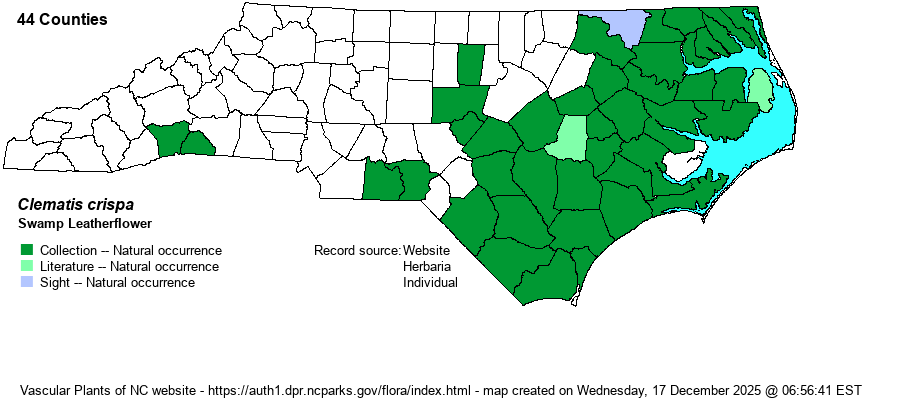| Author | L. | |
| Distribution | Throughout the Coastal Plain, including the eastern Sandhills region. Sparingly present in the eastern Piedmont, and a few records for the southern Blue Ridge Escarpment area.
This is a Southern species, mainly of the Coastal Plains. It ranges from eastern VA south to central FL, west to TX, and north up the Mississippi Valley to southeastern MO. | |
| Abundance | Fairly common to common in the Coastal Plain, though less numerous in the Sandhills. Very rare in the eastern Piedmont, and also in the southern Mountains, if still present there. | |
| Habitat | Habitat-wise, this is the Coastal Plain counterpart to C. virginiana of the Mountains and Piedmont, even though the flowers are quite different. It is a wetland species of marsh edges, openings and edges of bottomland forests and swamp forests, in wet thickets, and other damp and at least partly sunny ground. | |
| Phenology | Blooms from April to August, a wide period for blooming; fruits shortly after flowering. | |
| Identification | This is an herbaceous vine, typically climbing to about 6-8 feet long, with some branches. It has numerous opposite leaves, each pinnately divided into 3 or 5 leaflets, each one with entire margins. Not only are the leaves on petioles 1-2 inches long, but each leaflet is on a stalk up to 1 inch long. The entire margins separate this from C. virginiana, but the non-native C. terniflora, as well as the native C. viorna, also have entire margins to the leaflets. You may need to wait until flowers are present, as these three have completely different flowers. C. crispa and C. viorna have solitary flowers at the ends of each branch; the first has thick light blue to lavender-blue flowers (about 1-1.5 inches long) with strongly curved sepal tips to look like a flared bell; C. viorna has thick but urn-shaped flowers that are purplish-rose. The exotic species has thin, spread white flowers in clusters, very similar to those of C. catesbyana and C. virginiana. All of these species have "curly-head" fruit, composed of seeds (achenes) attached to feathery stalks. When walking along Coastal Plain bottomland openings, such as along a greenway, you likely will encounter this leatherflower fairly often. Thankfully, it has a long flowering period, and thus hopefully you will catch some of these vines in bloom, just to be sure it isn't the non-native one! | |
| Taxonomic Comments | None
| |
| Other Common Name(s) | Southern Leatherflower, Blue Jasmine, Marsh Clematis, Curly Clematis | |
| State Rank | S4 | |
| Global Rank | G5 | |
| State Status | | |
| US Status | | |
| USACE-agcp | FACW link |
| USACE-emp | FACW link |

